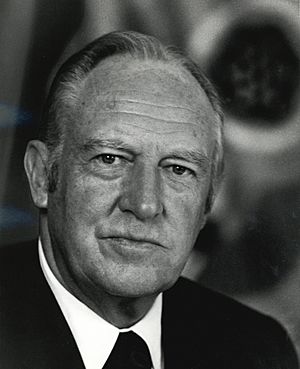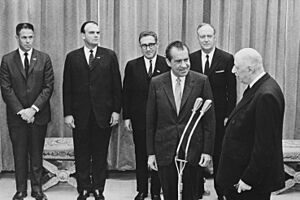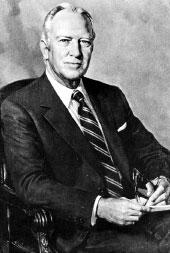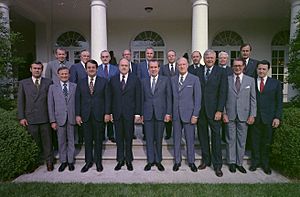William P. Rogers facts for kids
Quick facts for kids
William P. Rogers
|
|
|---|---|
 |
|
| 55th United States Secretary of State | |
| In office January 22, 1969 – September 3, 1973 |
|
| President | Richard Nixon |
| Preceded by | Dean Rusk |
| Succeeded by | Henry Kissinger |
| 63rd United States Attorney General | |
| In office October 23, 1957 – January 20, 1961 |
|
| President | Dwight Eisenhower |
| Preceded by | Herbert Brownell |
| Succeeded by | Robert F. Kennedy |
| 4th United States Deputy Attorney General | |
| In office January 20, 1953 – October 23, 1957 |
|
| President | Dwight Eisenhower |
| Preceded by | Ross L. Malone |
| Succeeded by | Lawrence Walsh |
| Personal details | |
| Born |
William Pierce Rogers
June 23, 1913 Norfolk, New York, U.S. |
| Died | January 2, 2001 (aged 87) Bethesda, Maryland, U.S. |
| Resting place | Arlington National Cemetery |
| Political party | Republican |
| Spouse |
Adele Langston
(m. 1937) |
| Children | 4 |
| Education | Colgate University (BA) Cornell University (LLB) |
| Signature | |
| Military service | |
| Allegiance | |
| Branch/service | |
| Rank | |
| Unit | USS Intrepid |
| Battles/wars | World War II |
William Pierce Rogers (born June 23, 1913 – died January 2, 2001) was an American lawyer and diplomat. He held important roles in the U.S. government. He served as the top lawyer for the country, called the United States Attorney General, under President Dwight D. Eisenhower. Later, he became the United States Secretary of State, which is the main foreign policy advisor, under President Richard Nixon.
Even though Rogers was a trusted friend of President Nixon, another advisor named Henry Kissinger became more famous for foreign policy. Kissinger later took over Rogers's role as Secretary of State.
Contents
Early Life and Schooling
William P. Rogers was born on June 23, 1913, in Norfolk, New York. After his mother passed away, his grandparents raised him in Canton (village), New York.
He went to Colgate University for his college degree. Then, he studied law at Cornell Law School. He was an editor for the Cornell Law Quarterly, a student law journal. He earned his law degree in 1937 and passed the New York bar exam that same year.
Career Highlights
After working for a law firm for about a year, Rogers became an assistant district attorney in 1938. He joined a special team led by Thomas E. Dewey. This team worked to fight organized crime in New York City.
Rogers joined the U.S. Navy in 1942 during World War II. He served on the ship USS Intrepid. He was part of the action during the Battle of Okinawa. He reached the rank of lieutenant commander.
Working for the Government
After the war, Rogers worked for the United States Congress as a legal advisor for a committee.
Investigating Important Cases
While working for a Senate committee, Rogers helped investigate a case involving Alger Hiss. He looked at documents from another committee, the House Un-American Activities Committee. He advised Representative Richard Nixon that Hiss had not been truthful.
Rogers also consulted with the United States Attorney General's office about an investigation that began with Elizabeth Bentley. This investigation focused on national security matters.
Private Law Practice
In 1950, Rogers became a partner in a law firm in New York City. He returned to this firm whenever he was not working in government.
Rogers advised Richard Nixon during a time when Nixon faced questions about his campaign funding in 1952. This led to Nixon's famous "Checkers speech."
Deputy Attorney General
In 1953, Rogers joined President Dwight D. Eisenhower's team. He became the United States Deputy Attorney General, the second-highest lawyer in the country.
As Deputy Attorney General, Rogers helped manage important legal matters. He was involved in the Little Rock Integration Crisis in 1957. This was when nine African American students tried to attend Little Rock Central High School in Little Rock, Arkansas. Rogers worked with local officials to make sure federal orders were followed and to keep peace in the city.
Attorney General (1957–1961)
Rogers served as the United States Attorney General from 1957 to 1961. He was a close advisor to Vice President Nixon during this time.
Rogers became Attorney General after Herbert Brownell Jr. resigned. Brownell had worked to desegregate Little Rock Central High School. In 1958, Little Rock closed its public schools for a year to avoid further desegregation. Rogers said it was "inconceivable" that a community would close schools rather than follow Supreme Court decisions.
In 1959, Martin Luther King Jr. praised Rogers. Rogers had supported the integration of an elementary school in Alabama. This school had not allowed children of black military personnel.
Return to Private Practice
After his time as Attorney General, Rogers returned to his law practice. His firm was renamed Rogers & Wells. He worked there until he was in his early eighties. He played an important role in New York Times Co. v. Sullivan, a major Supreme Court case in 1964.
From 1962 to 1963, Rogers led the Federal City Council. This group worked on economic development in Washington, D.C.

Secretary of State (1969–1973)
Rogers became United States Secretary of State in the Nixon administration on January 22, 1969. He served until September 3, 1973. President Nixon wanted to manage foreign policy directly from the White House. He often used his national security advisor, Henry Kissinger, for important decisions.
Kissinger became Nixon's main advisor on foreign affairs. Rogers was chosen as Secretary of State partly because he was new to foreign policy. This meant he was less likely to challenge Nixon's plans. Kissinger later said that few secretaries of state were chosen because they didn't know much about foreign policy.
One of Rogers's goals was to work for peace in the Arab–Israeli conflict. This effort was known as the Rogers Plan in December 1969. However, his influence was often limited. Nixon preferred to handle major foreign policy decisions with Kissinger.
For example, Nixon and Kissinger discussed bombing bases in Cambodia in secret. Rogers felt this was not a good idea. He worried it might hurt peace talks. Later, Kissinger held secret meetings with North Vietnamese diplomats. Rogers was not told about these meetings until a year later.
On October 15, 1973, President Nixon gave Rogers the Presidential Medal of Freedom. This is one of the highest civilian awards in the United States. His wife, Adele Rogers, also received an award at the same ceremony.
Later Life and Legacy
In 1982, Ronald Reagan asked Rogers to take part in a military exercise. Rogers played the role of the U.S. president in this training.
Rogers also led the investigation into the explosion of the space shuttle Challenger. The Rogers Commission was the first investigation to criticize NASA for not focusing enough on safety. Famous members of his team included astronauts Neil Armstrong and Sally Ride, and physicist Richard Feynman.
Rogers continued to work at his law firm, which later merged to become Clifford Chance Rogers & Wells. He worked there until a few months before he passed away.
Personal Life
William Rogers married Adele Langston in 1937. She was also a law student he met at Cornell. They had four children together.
William P. Rogers passed away on January 2, 2001, at age 87. He was buried at Arlington National Cemetery.
In 2001, Rogers's family donated many of his materials to Cornell Law Library. These materials mostly cover his time as Secretary of State.
See also
 In Spanish: William P. Rogers para niños
In Spanish: William P. Rogers para niños



